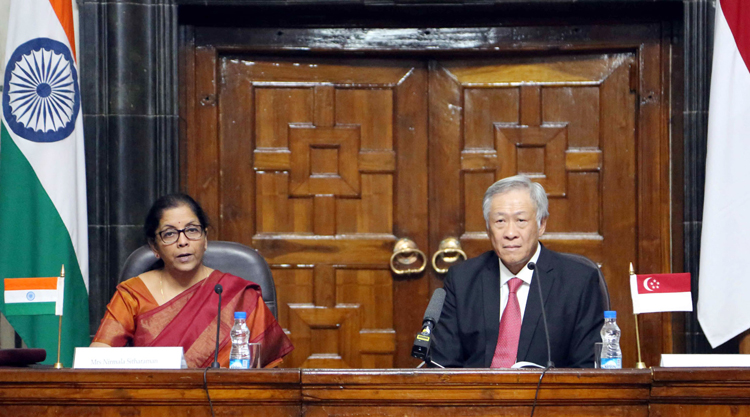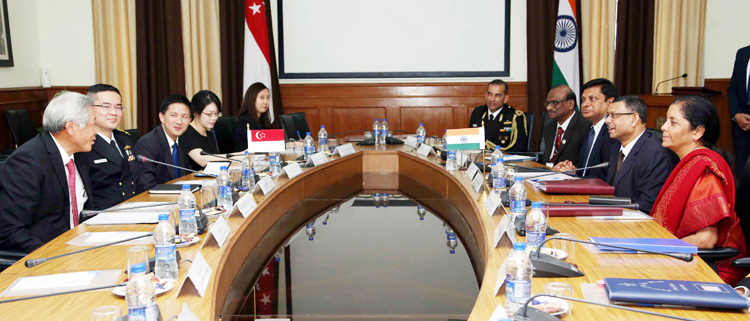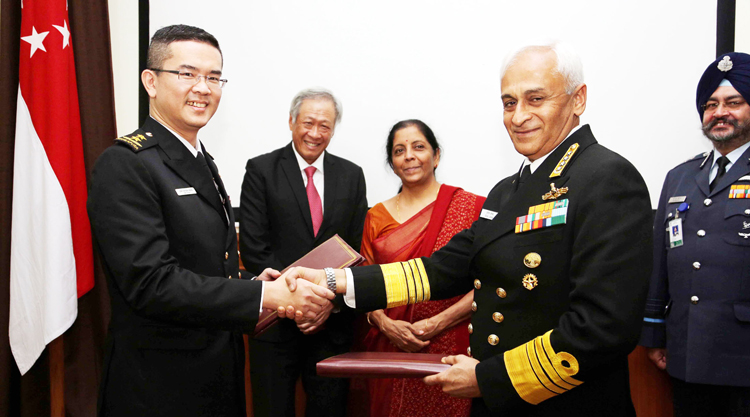INDIAN ARMED FORCES CHIEFS ON
OUR RELENTLESS AND FOCUSED PUBLISHING EFFORTS

SP Guide Publications puts forth a well compiled articulation of issues, pursuits and accomplishments of the Indian Army, over the years

I am confident that SP Guide Publications would continue to inform, inspire and influence.

My compliments to SP Guide Publications for informative and credible reportage on contemporary aerospace issues over the past six decades.
- Prime Minister witnesses 'Bharat Shakti' – a Tri-Services Firing and Manoeuvre Exercise in Pokhran, Rajasthan
- Interim Defence Budget 2024-25 — An Analysis
- Union Defence budget 2024
- Indian Army: In quest of greater firepower and policy recommendations for gaps
- Indian Army Annual Press Conference 2024
- 6G will transform military-industrial applications
India-Singapore — Deepening defence relations, Source of Envy for China

The second India Singapore Defence Ministers dialogue held on 29th November had the following five significant takeaways.
- Conclusion of India Singapore bilateral agreement for Navy Cooperation
- Agreement on renewal of the Army bilateral Agreement early next year.
- Agreement on continuous and institutional naval engagements in each other's shared maritime space.
- Establishment of maritime exercises with like-minded regional / ASEAN partners.
- Singapore appreciates India's offer of its test ranges and infrastructure for the conduct of testing and evaluation of R&D projects.
With these significant dose of new agreements, the latest round of Defence Ministers Dialogue will help India-Singapore defence and strategic relations cross new milestones in promoting each others' strategic interests in the region and jointly play a significant role in ensuring peace, stability and maritime security in the Indo-pacific maritime area. Deepening India-Singapore strategic partnership has therefore been a source of envy for China, who has been making aggressive moves to expand its territorial ambitions. Singapore has been a key pillar of India in promoting India-ASEAN relations and has been instrumental in promoting India's 'Look East' and now improvised 'Act East' policy. Singapore has been one of the most vocal admirer of India's role in promoting strategic relations with the ten member ASEAN bloc.
India-Singapore defence relations and cooperation have been deepening over the years and has thus been a source of strength to each others' strategic agenda. The agreement will enable India to access Singapore naval bases with refuelling and berthing facilities. Prominent among them would be the Changi naval base, which has the capacity to handle aircraft carriers. India thus would get the opportunity to deploy its aircraft carrier in the Malacca Strait and take advantage of its location in case of any large scale conflict situation. This will help advance significantly the operational reach of the Indian warships and fighters east of the Malacca Strait. Since this is a critical chokepoint of the major trade routes, China would be worried as this is a major energy supply route for them. In return India will provide the Singapore navy with drills and logistics facilities for the Singaporean warships in the Andaman Sea. Singapore already enjoys such facilities for its Air Force and Army at Indian bases since last one decade.

The Singaporean defence minister Dr Ng Eng Hen, commenting on this agreement, said that India has a leading role in the Indian Ocean Region and would encourage more Indian warships to come to its shores and help in further securing sea lanes of communication towards the Andaman Sea and the Strait of Malacca. Singapore also wants to expand and institutionalise maritime exercises with like-minded regional and ASEAN partners. Dr Hen said that we want to see more participation and activity in both the Strait of Malacca and the Andaman Sea. It was crucial to join forces against terrorism, chemical, biological and radiological threats. Indian Defence Minister Nirmala Sitharaman responded by saying that India and Singapore have decided to expand overall defence ties and were strongly committed to boosting cooperation in tackling transnational security threats, especially terrorism.
The low key visit of the Singapore defence minister to India produced such significant results that the regional players will be forced to take note of. The visit attracted media attention only when Dr Hen visited Kalaikunda, India's premier air base in the Eastern region facing China and flew the home-made Light Combat Aircraft the Tejas and described it as excellent aircraft. Singapore uses the Kalaikunda airbase for training of its air warriors. The Singapore Air Force transports its entire F-16 squadron and other planes to Kalaikunda for a month. Singapore being a City-State, the densely populated country has no open airspace for practice of its air warriors. Similarly Singapore Army also uses the Babina and Deolali army base for training its soldiers. Singapore sends its mechanised forces to Babina and Artillery units at Deolali. Now the land and air warrior training facilities in India will be extended to the maritime domain. India and Singapore has been taking part in the annual SIMBEX naval war games, which have evolved from an anti-submarine warfare exercises to complex level which involves multiple facets of operation at Sea, including the air element.
The second India Singapore Defence Ministers Dialogue was conducted after both the countries signed the revised Defence Cooperation Agreement (DCA) in 2015 to further strengthen the long standing defence relationship between the Singapore Armed Forces and the Indian Armed Forces. According to the spokesperson of the Ministry of Defence, "Of particular significance during the meeting was the conclusion of the India Singapore bilateral agreement for navy cooperation which will lead to increased cooperation in maritime security, joint exercises , temporary deployment from each other's naval facilities and mutual logistics support."

The Singapore defence minister expressed his appreciation for India's continued support for the SAF's training in India, covered by the Air Force and Army Bilateral agreements. Both Ministers welcomed the renewal of the Air Force Bilateral Agreement on the sidelines of the 11th Singapore-India Defence Policy Dialogue in January this year, and looked forward to the successful renewal of the Army Bilateral Agreement next year.
Of particular relevance was the convergence on issues relating to maritime freedom of navigation and trade, consistent with international law. This is significant because China is sick of hearing this narrative from its maritime neighbours and rival countries.
Since the air forces and naval vessels of all the major regional players regularly criss-cross the maritime and air domain, the two defence ministers discussed the issues relating to accidental encounters and between naval ships and aircraft. In fact this was the proposal from the Singapore side to expand the code of unplanned encounters at Sea to all ADMM (ASEAN Defence Ministers' meeting)-plus countries. Both the countries discussed the need for establishing guidelines to reduce the chances of miscalculations. In view of the aggressive deployment by China of its military assets in the South China Sea, the code will attract the attention of all the major players in the Indo-pacific region.
In fact this is the need of the hour. With the emerging rivalry in the Indo pacific region between India and China, China and Japan, China and Vietnam and other ASEAN members, China and US, the code needs to be put on the formal agenda of the ADMM dialogue and immediately implemented to prevent any major clash.
Besides deepening cooperation between the armed forces of the two countries, both defence ministers commended the progress made since the India-Singapore Defence Technology Steering Committee was set up in October 2006 to launch joint research projects.
The Joint Statement issued after Nirmala-Hen talks, also referred to the significant progress made in defence industry cooperation, with the signing of the terms of reference for the Defence Industry Working Group (DIWG) in August this year. Both Ministers agreed that this would facilitate greater collaboration in aerospace, electronics and other areas of mutual interest between the defence industries of both countries.
With China in mind India has been engaged over the years with other ASEAN partners like Vietnam, Malaysia, Indonesia, Thailand, Myanmar and Singapore, to strengthen defence and security ties. With Singapore one can safely claim that India has the strongest defence relations among all the ASEAN partners and the latest round of India Singapore Defence Dialogue will take the defence cooperation to new strategic heights.
(The writer is a Strategic Analyst)





